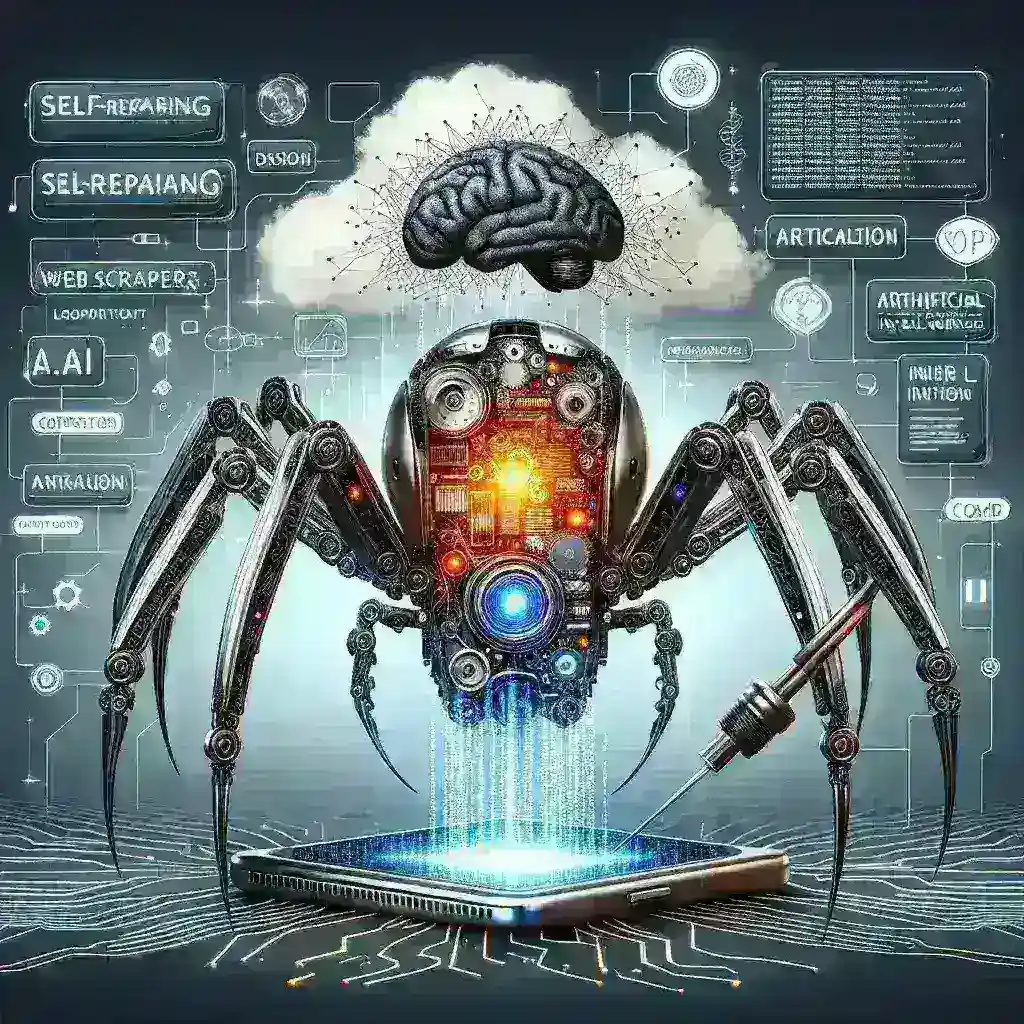Web scraping has become an essential tool for businesses and developers who need to extract data from websites at scale. However, traditional scrapers are fragile and often break when websites change their structure, update their layouts, or implement new anti-bot measures. This is where artificial intelligence comes to the rescue, enabling the creation of self-healing scrapers that can automatically adapt to changes and maintain consistent data extraction performance.
Understanding Self-Healing Scrapers
Self-healing scrapers are intelligent data extraction systems that use AI and machine learning algorithms to automatically detect when something goes wrong and fix themselves without human intervention. Unlike traditional scrapers that follow rigid rules and break when websites change, these adaptive systems can recognize patterns, learn from failures, and adjust their behavior accordingly.
The concept draws inspiration from biological systems that can repair themselves when damaged. In the context of web scraping, this means creating systems that can identify when extraction rules are no longer working, understand why they failed, and implement alternative strategies to continue collecting data successfully.
Core Components of AI-Powered Self-Healing Systems
Intelligent Error Detection
The foundation of any self-healing scraper is its ability to detect when something has gone wrong. Traditional scrapers might simply return empty results or crash when encountering unexpected changes. AI-powered systems, however, can implement sophisticated error detection mechanisms:
- Pattern Recognition: Machine learning models can identify when extracted data doesn’t match expected patterns or formats
- Anomaly Detection: Statistical models can flag unusual changes in data volume, structure, or content quality
- Visual Analysis: Computer vision techniques can detect layout changes by analyzing page screenshots
- Response Validation: Natural language processing can verify that extracted content makes semantic sense
Adaptive Parsing Mechanisms
Once an error is detected, the system needs to adapt its parsing strategy. This involves several AI-driven approaches:
Dynamic Selector Generation: Instead of relying on static CSS selectors or XPath expressions, AI systems can analyze page structure and generate new selectors on the fly. Machine learning models trained on HTML patterns can identify the most reliable ways to locate target elements even after layout changes.
Content-Based Extraction: Natural language processing and computer vision can identify target content based on its meaning rather than its location. For example, instead of looking for a price in a specific div, the system can recognize price patterns anywhere on the page.
Learning and Memory Systems
Self-healing scrapers need memory to learn from past experiences and improve over time. This involves implementing several key components:
- Historical Data Analysis: Tracking successful and failed extraction attempts to identify patterns
- Model Training: Continuously updating machine learning models based on new data and feedback
- Strategy Repository: Maintaining a library of successful extraction strategies for different scenarios
- Confidence Scoring: Assigning reliability scores to different extraction methods
Implementation Strategies and Technologies
Machine Learning Frameworks
Building self-healing scrapers requires leveraging appropriate machine learning frameworks and libraries. Popular choices include:
TensorFlow and PyTorch for building custom neural networks that can analyze page structures and predict optimal extraction strategies. These frameworks are particularly useful for implementing computer vision models that can understand page layouts visually.
Scikit-learn provides excellent tools for implementing anomaly detection algorithms and classification models that can categorize different types of pages and determine appropriate extraction strategies.
Natural Language Processing libraries like spaCy and NLTK help in understanding and validating extracted content, ensuring that the data makes semantic sense.
Architecture Design Patterns
Successful self-healing scrapers typically follow specific architectural patterns:
Microservices Architecture: Breaking the scraper into smaller, independent services allows for better fault isolation and easier updates. Each service can handle specific aspects like error detection, strategy selection, or data validation.
Event-Driven Design: Using message queues and event streams enables real-time response to failures and allows different components to communicate asynchronously.
Feedback Loops: Implementing continuous feedback mechanisms ensures that the system learns from both successes and failures, constantly improving its performance.
Advanced AI Techniques for Robust Scraping
Computer Vision Integration
Modern self-healing scrapers increasingly rely on computer vision to understand web pages visually rather than just parsing HTML. This approach offers several advantages:
Visual element detection can identify buttons, forms, and data regions even when the underlying HTML structure changes completely. Convolutional neural networks can be trained to recognize common web page patterns and elements across different websites.
Screenshot analysis allows the system to detect layout changes immediately and adjust extraction strategies accordingly. This is particularly useful for dynamic websites that heavily rely on JavaScript rendering.
Reinforcement Learning Applications
Reinforcement learning provides an excellent framework for creating scrapers that improve through trial and error:
- Strategy Selection: RL agents can learn which extraction strategies work best for different types of pages
- Resource Optimization: Learning optimal timing, request patterns, and resource allocation
- Anti-Bot Evasion: Developing sophisticated patterns to avoid detection while maintaining extraction efficiency
Natural Language Understanding
Advanced NLP techniques enable scrapers to understand content contextually:
Semantic Analysis: Understanding the meaning of extracted data to validate its correctness and relevance. This helps identify when extraction has gone wrong even if the format appears correct.
Entity Recognition: Automatically identifying and extracting specific types of information like names, dates, prices, and addresses without relying on specific page structures.
Practical Implementation Steps
Phase 1: Foundation Building
Start by implementing basic monitoring and logging systems that can track scraper performance and identify when things go wrong. This includes setting up metrics for success rates, data quality scores, and response times.
Develop a robust testing framework that can automatically validate extracted data against expected patterns and formats. This forms the foundation for more advanced AI-driven validation systems.
Phase 2: AI Integration
Begin integrating machine learning models for pattern recognition and anomaly detection. Start with simple models and gradually increase complexity as you gather more data and understand your specific use cases better.
Implement adaptive selector generation using machine learning models trained on HTML structure patterns. This allows the scraper to generate new extraction rules when existing ones fail.
Phase 3: Advanced Features
Add computer vision capabilities for visual page analysis and element detection. This provides a backup extraction method when HTML-based approaches fail.
Implement reinforcement learning systems that can optimize extraction strategies based on success rates and efficiency metrics.
Challenges and Considerations
Computational Overhead
AI-powered scrapers require significantly more computational resources than traditional ones. The trade-off between intelligence and efficiency must be carefully managed, especially when scraping at scale.
Training Data Requirements
Machine learning models need substantial amounts of training data to work effectively. This means investing time in collecting and labeling examples of successful and failed extractions across different websites and scenarios.
Ethical and Legal Considerations
Self-healing scrapers are more sophisticated and potentially more invasive than traditional ones. It’s crucial to ensure compliance with website terms of service, robots.txt files, and relevant data protection regulations.
Future Trends and Developments
The field of AI-powered web scraping continues to evolve rapidly. Large language models are beginning to show promise for understanding web page content and structure in more sophisticated ways. These models can potentially generate extraction code automatically based on natural language descriptions of what data to extract.
Edge computing and distributed AI systems are making it possible to deploy intelligent scraping capabilities closer to data sources, reducing latency and improving real-time adaptation capabilities.
The integration of blockchain technology is also emerging as a way to create transparent and auditable scraping systems that can prove the authenticity and origin of extracted data.
Conclusion
Creating self-healing scrapers with AI represents a significant advancement in data extraction technology. While the implementation requires substantial technical expertise and computational resources, the benefits of having robust, adaptive scraping systems far outweigh the costs for organizations that rely heavily on web data.
The key to success lies in starting with solid foundations, gradually integrating AI capabilities, and continuously learning from both successes and failures. As AI technologies continue to advance, we can expect self-healing scrapers to become even more sophisticated and accessible to a broader range of users.
By embracing these technologies today, developers and businesses can build more reliable, efficient, and maintainable data extraction systems that will continue to perform well as the web evolves and becomes increasingly dynamic and complex.







Leave a Reply